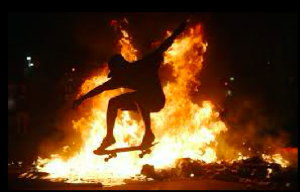
Yes, it’s scary. The endless wail of police sirens through the night. The ongoing rumble of helicopters in the sky. The aroma of metal burning, the gleam of shattered glass in the lamppost light, the chorus of rage coming from every direction. It’s horrible to live in a riot zone—and now it’s risky, not just microbally, but politically, because no one knows which side these events will ultimately benefit. Very scary. But utterly necessary. Because the cities under greatest siege are led by liberals, and they haven’t stopped the carnage inflicted on black men by the police. The point has to be made that maintaining the status quo will be very expensive, as destructive to the future of cities as any disease.
Antifa is the new target for Trump and his minions. Of course. There will always be engines of adrenaline in a rebellion, and they will always give the other side a weapon. Back in day, bad-ass revolutionaries were front and center—remember Abbie Hoffman? Other anarchists had none of his wit or aplomb. I recall that a group called Up Against the Wall Motherfuckers would disrupt peaceful protests, agitating the crowd. Then there was the Weather Underground, spasmodic with violence. But the war in Vietnam was real, and so is police brutality. The recourse to disorder was as necessary in the ‘60s as it is today.
But the most important similarity between the rebellions of my youth and the outburst of rage today has only been mentioned by the press in passing. This is very much a youth event. The bicycles, the tagging, the skateboards—all are evidence of a culture emerging on the political stage. Only young people could risk police violence and viral contagion to show up at these marches, and so the streets were theirs. That made it impossible not to notice the most auspicious difference between this racial rebellion and its predecessors in the 60s. Back then, the only white people in the mob were cops, soldiers, and reporters huddling at the edges. But the cast of this year’s protest was decisively multiracial. Blacks and whites joined forces in militant solidarity. This isn’t just a reflex. It’s a mark of what makes this cohort distinct. They are the most ethnically diverse generation in American history. For many of them, multiculturalism is a tangible part of everyday life. And there they were, by the thousand, proclaiming that race is not a tool of hierarchy. It’s a reality waiting to assert itself. Of course, this attitude is utopian. Our whole history argues against it. But unlike progressives of my age, who had to devise quotas in order to achieve racial parity, these young people are edging toward living it. That is a change with enormous consequences.
As is the thing about these protests that, I believe, will be their most enduring legacy. This is a generational announcement. Here they are. They have an agenda. You will deal with it or they will shut you down. They have felt this way for a long time, but, caught between the distractions of media and a gnawing sense of political helplessness, prone to skepticism as a defense, many of them have felt that it was a waste of precious energy to act. But now it’s clear that the world they are facing is not the one they were raised to expect. It is a world of rampant disease and environmental calamity, with waves of refugees from uninhabitable zones; a world of school shootings and massive student debt, of income inequality that shatters the pretenses of unregulated capitalism; of spreading authoritarianism and surveillance; a world of cops. Suddenly nothing they counted on can be counted on. Not work, not safety, not wealth or even longevity. And racism is a hydra, choking—sometimes literally—the life out of them. All these realities are converging in the most terrifying way. It’s not appropriate to call young people Generation Z. They are the Crisis Generation, and now they know it.
How do I know it? I don’t. As a teacher, I only have a hunch. And as a product of the ‘60s, I’m prone to see every picket line as a harbinger of a mass movement. I’m also prone to worry about the repercussions of rebellions. After all, I acted up fecklessly in my youth, along with many of my peers, and in the end we ushered in Richard Nixon. But it’s not in youth to let history determine the course of action. I’m glad about that. Even gladder to see the evidence that the sensibility of hip-hop is finally expressing itself in a graffiti-strewn style of protest. I have always told my students that they have great ideas and a much greater grasp of reason than I did at their age, but I’ve also said that they can’t bring these values to power unless they organize. Now, I think, they are taking a step beyond the inchoate agenda of Occupy Wall Street. They have a concrete issue that opens the door to many other issues; they have a sense of urgency and a precedent for future action. That’s why I see this rebellion as a chrysalis. Within its soft walls, something new is growing.
The thing I most worry about is what will become of their capacity for gentleness. It’s made them the butt of everyone who can’t access the sensitivity within themselves. The whole point of civilization is to create the space and safety to be gentle. So, even in a time as harsh as this, acuity is worth fighting for. But how can you fight for your right to be gentle? How can you be a snowflake while setting fire to a police car? The answer is that gentleness does not preclude aggression when the threat is real. Gentle shows its face when it can, and its claws when it must.